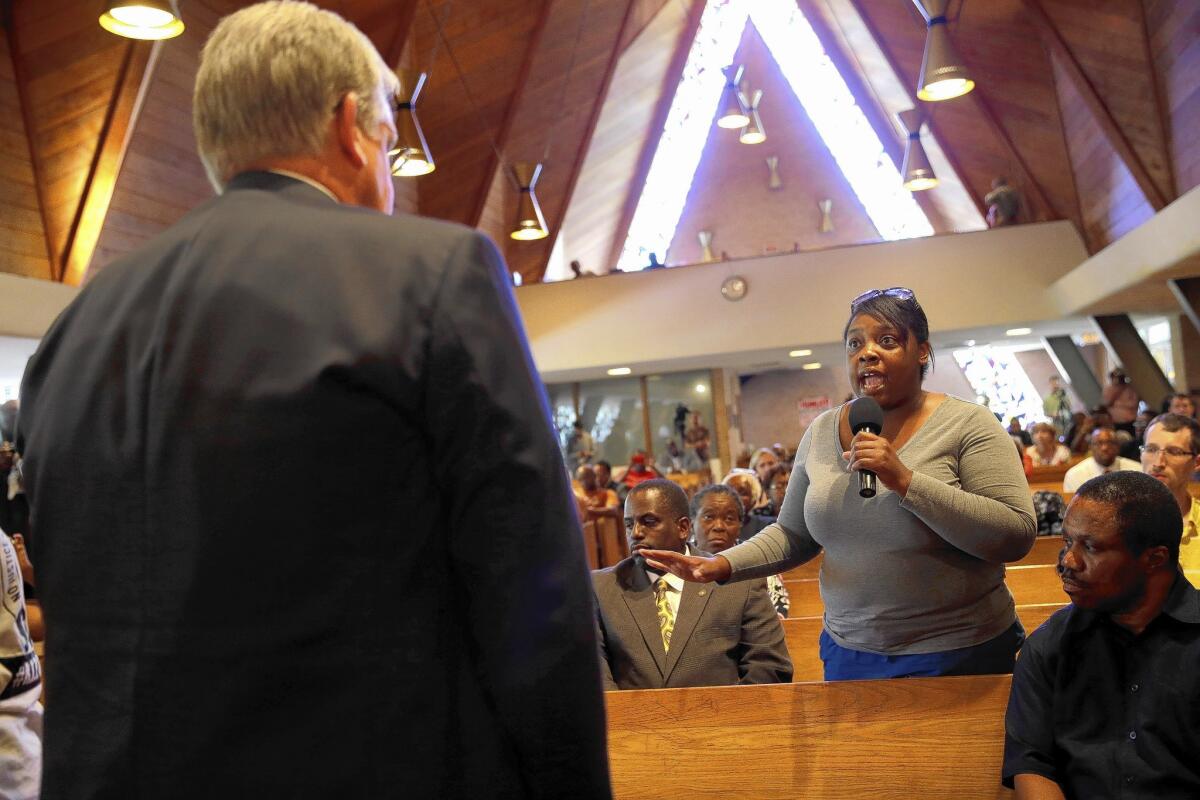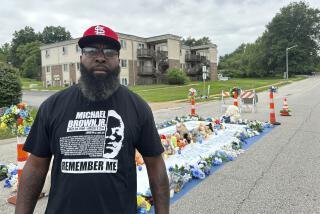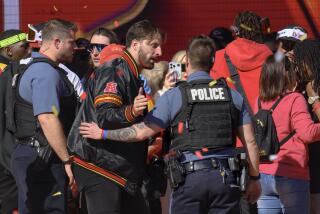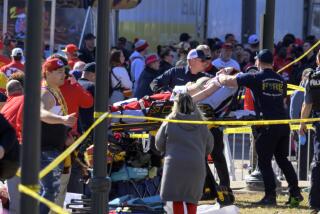State police take over security in Ferguson, Mo., with ‘softer’ stance

- Share via
reporting from FERGUSON, Mo. — After several nights of tense street confrontations, state and federal authorities stepped in Thursday to curb the aggressive tactics of local police against demonstrators protesting the police shooting of an unarmed black teenager.
Missouri Gov. Jay Nixon dispatched the State Highway Patrol to take over security in Ferguson, promising “a softer front” to law enforcement after images of police wielding automatic weapons, flash grenades and tear gas drew stunned reactions from across the country.
“Ferguson will not be defined as a community that was torn apart by violence but will be known as a community that pulled together to overcome it,” Nixon said at a news conference.
Highway Patrol Capt. Ron Johnson, who is black and grew up in this predominantly black suburb of St. Louis, was tapped to lead the effort. “It means a lot to me personally that we break this cycle of violence,” he said.
Later in the day, Johnson joined demonstrators near the scene of previous confrontations stemming from the fatal weekend shooting and exchanged hugs and handshakes with protesters as they passed. Officers stood by with casual demeanors, without visible body armor or rifles.
One man told Johnson that his niece had been hit with tear gas during the demonstrations. “What would you say to her?” the man asked.
“Tell her Capt. Johnson is sorry and he apologizes.”
President Obama weighed in from his vacation in Martha’s Vineyard, Mass., saying that he had asked U.S. Atty. Gen. Eric H. Holder Jr. to investigate the shooting of 18-year-old Michael Brown, who several witnesses said had his hands up when he was killed. The president was also critical of the arrest of two journalists covering the unrest.
“We lost a young man, Michael Brown, in heartbreaking and tragic circumstances,” the president said. “He was 18 years old, and his family will never hold Michael in their arms again.”
Obama issued a stern admonition to both police and looters.
“There is never an excuse for violence against police or for those who would use this tragedy as a cover for vandalism or looting,” he said.
“There’s also no excuse for police to use excessive force against peaceful protests or to throw protesters in jail for lawfully exercising their 1st Amendment rights,” he said. “Police should not be bullying or arresting journalists who are just trying to do their jobs and report to the American people on what they see on the ground.”
Holder said federal agents would help authorities “conduct crowd control and maintain public safety without relying on unnecessarily extreme displays of force.”
The racial dynamic of the city has long been a volatile mix: Two-thirds of residents are black, and police and city officials are predominantly white.
When demonstrations began after the shooting Saturday, the feeling that police viewed residents as enemy combatants inflamed anger on the streets, as did officials’ refusal to release the name of the officer who shot Brown.
Large protests over the last several days have been mostly peaceful during daylight hours. But after vandals looted 12 businesses Sunday night, officers in military vehicles and riot gear swarmed into neighborhoods ordering demonstrators and residents to leave.
The officers fired stun grenades, tear gas canisters, bean bags and rubber bullets on those who refused. A small minority of the crowds lobbed bottles, rocks and Molotov cocktails.
Similar clashes repeated over the next three nights.
Sen. Claire McCaskill (D-Mo.) had urged the Justice Department to take a stronger role in ending the crisis.
“We need to demilitarize the situation,” she said. “This kind of response by the police has become the problem instead of the solution.... My constituents are allowed to have peaceful protests.”
At a church in Florissant, a town neighboring Ferguson, residents expressed their outrage over Brown’s killing. They said they also were concerned about the aggressive police presence in the area.
“A lot of people are scared to death to come outside,” said Sierra Smith, 27, who lives near where Brown was shot.
She described how police had blocked the streets around her apartment complex at night.
A neighbor with a 3-week-old baby was blocked by police from going out for formula and diapers when she ran out, she said.
Tremaine Combs, 32, said he took his son on an errand to Walgreens when his son spotted a police officer driving by.
“He was so terrified that he started crying, and he’s only 5 years old,” Combs said.
Dozens of demonstrators took to the sidewalks and median in front of the burned-out husk of a QuikTrip gas station and convenience store on West Florissant Avenue, holding signs calling for justice for Brown.
“So far, no police is around; that’s the way I like it,” said Dion Dupree, 21, who lives nearby. “I haven’t been to work all this week. Leave us alone, and let us get our justice.”
Tishawn Stroud, 30, said the police’s tactics had created an ugly cycle.
“When the public sees things like that, they feel like they’re in a war zone,” Stroud said. “Then they begin acting like they’re in a war zone.”
Clark McPhail, one of the top experts on controlling public gatherings and an emeritus professor at University of Illinois Urbana-Champaign, said police appeared to have made serious errors in handling the scene in Ferguson.
“They were geared up as though they were going into combat,” he said. “I am always stunned when I see police agencies behave that way in the 21st century.”
Plumes of tear gas have appeared nearly every night, enforcing the picture of suburban Ferguson as a battleground.
Riot control experts say the use of tear gas can not only quell unrest, but can incite it if not used properly.
In 1993, after a two-month standoff, federal agents fired tear gas into a compound occupied by the Branch Davidians near Waco, Texas, triggering years of investigation into the subsequent conflagration that took 76 lives.
Seattle police in 1999 fired so much tear gas into crowds of thousands who were protesting a World Trade Organization meeting that they ran short of canisters.
Paul Wertheimer, a crowd control expert who runs the consulting firm Crowd Management Strategies, said chemical irritants can be controversial but were sometimes needed. “It’s not the worst thing you can do to people.”
Johnson, of the Highway Patrol, did not say whether his officers would use tear gas. But other officials in the agency said tactical vehicles and SWAT teams would not be on the front lines.
As officers and federal agents planned for Thursday night’s deployment, FBI and Justice Department investigators from St. Louis and Washington spoke with people who witnessed the Brown shooting, Holder said.
He said the Justice Department was pushing ahead with a federal investigation in the case, saying it would be “thorough and fair,” but cautioning that the review would “take time to conduct.”
The ACLU of Missouri filed a lawsuit seeking to obtain copies of initial police reports on the shooting after its open records request for the incident report was rejected by police Wednesday.
Meanwhile, a Democratic congressman said he was planning to introduce a bill to restrict a Defense Department program that provides machine guns and other surplus military equipment for free to law enforcement agencies.
Rep. Hank Johnson (D-Ga.) wrote to colleagues that city streets should be a place for businesses and families, “not tanks and M-16s.”
“Our local police are quickly beginning to resemble paramilitary forces,” Johnson wrote.
For more news about Ferguson, follow @mattdpearce on Twitter.
Pearce reported from Ferguson and Mozingo from Los Angeles. Times staff writers Lauren Raab, Maya Srikrishnan and Ralph Vartabedian in Los Angeles and Richard A. Serrano in Washington contributed to this report.
More to Read
Sign up for Essential California
The most important California stories and recommendations in your inbox every morning.
You may occasionally receive promotional content from the Los Angeles Times.












